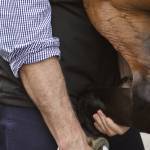Poor Performance in Sport Horses

Many studies outline common causes of poor performance among racehorses, but there is less information available for sport horses that fail to live up to expectations.
Poor performance in three-day-event and other sport horses, like racehorses, can often be linked to more than one cause. In order to pinpoint the most likely reasons, it is important for a veterinarian to adopt a methodical approach to a poor-performance workup. In addition to sharing a thorough history of your horse with your veterinarian, examining the horse under tack or in work often proves beneficial, which may sound unusual to those in the racing industry.
“Sport horses must be visualized as they’re doing their respective jobs,” commented Laura Petroski-Rose, B.V.M.S., a Kentucky Equine Research veterinarian. “This means under tack with their usual rider, or in harness if they’re driving horses, on top of footing they’re used to working on.”
“These workups can be very intense, with different methods adopted by clinicians, including holistic approaches that involve observation from first contact between rider and horse to using two riders to assess whether there is any change in the horse’s behavior,” stated Petroski-Rose.
In a retrospective assessment of 200 cases presented to an equine hospital for poor performance, researchers found that 77% suffered from a musculoskeletal issue. Less commonly, 15% were found to have an internal medicine issue, including respiratory and gastrointestinal disease.
In the three-day-event horses, particularly, it was determined that discipline-specific issues related to repetitive stress and strain on the musculoskeletal system due to uneven ground or varied footing conditions were a common denominator. The most common injuries seen in this population of horses included subchondral bone disease, caudal heel pain, superficial digital flexor tendinitis, suspensory desmopathy, back pain, and concussive stress-related injury due to overtraining.
The consequences of overtraining occur because there is insufficient time for an athlete, human or animal, to recover after strenuous exercise. This has been well documented in human athletes and is identified by clinical signs consisting of chronic fatigue and harmful changes to mental and physical health.
Researchers are currently working on a way to score behavioral changes seen in horses to improve early detection of overtraining. “Sport horse owners should invest in heart rate monitors for use during exercise. Monitoring your horse’s heart rate during rest, light work, and intense exercise may prove advantageous if any abnormal trends are discovered,” mentioned Petroski-Rose.
KER ClockIt, a smartphone application developed by Kentucky Equine Research, can be used with a small heart-rate monitoring device placed under the saddle for real-time assessment of your horse’s heart rate during exercise.
Worried about soft tissue and joint-related disease? Consider Synovate HA, a hyaluronic acid supplement designed to maintain health of the connective tissue and optimize normal joint function. To improve management of bone health and tackle gastrointestinal issues, Kentucky Equine Research recommends Triacton, a triple-action supplement designed to improve bone density and support digestive health in horses. This product contains an array of highly bioavailable minerals and vitamins essential for sound skeletal development and maintenance, including magnesium, boron, silicone, iodine, zinc, manganese, as well as vitamins A, C, D, and K.
Ober, C.L. 2018. Poor performance workup in the eventing or English sport horse. In: Proc. American Association of Equine Practitioners Convention. 64:199-203.








